Characterization of Mode I and Mode II Interlaminar Fracture Toughness in CNT-Enhanced CFRP under Various Temperature and Loading Rates
Abstract
:1. Introduction
2. Materials and Methods
2.1. Interlaminar Fracture Toughness in Mode I and Mode II
2.2. Materials
2.3. Samples Preparation
2.4. Experimental Procedure
2.4.1. DCB Experimental Tests
2.4.2. ENF Experimental Tests
2.5. Fracture Examination
3. Results
3.1. Mode I (DCB) Test
3.1.1. CNT Areal Density Effect
3.1.2. Loading Rate Effect
3.1.3. Temperature Effect
3.2. Mode II (ENF) Test
3.2.1. CNT Areal Density Effect
3.2.2. Loading Rate Effect
3.2.3. Temperature Effect
3.3. Microstructural Analysis
3.3.1. Fracture Analysis of DCB Samples with Varying CNT Areal Density
3.3.2. Fracture Analyses of DCB Samples with Varying Temperature
4. Conclusions
Author Contributions
Funding
Data Availability Statement
Conflicts of Interest
References
- Ma, H.; Aravand, M.; Falzon, B.G. Influence on fracture toughness arising from controlled morphology of multiphase toughened epoxy resins in the presence of fibre reinforcement. Compos. Sci. Technol. 2022, 217, 109095. [Google Scholar] [CrossRef]
- Feng, X.; Ye, J.; Liu, L. Thickness and pore effect of nanotube interleaves on interlaminar shear properties of carbon fibrous laminates. Compos. Commun. 2022, 29, 100998. [Google Scholar] [CrossRef]
- Han, C.L.; Wang, G.-D.; Li, N.; Wang, M.; Liu, X.L.; Ma, J.H. Study on interlaminar performance of CNTs/epoxy film enhanced GFRP under low-temperature cycle. Compos. Struct. 2021, 272, 114191. [Google Scholar] [CrossRef]
- Yenigun, B.; Kilickap, E. Influence of hole quality on fatigue life of drilled CFRP with the different ply orientation angle. J. Braz. Soc. Mech. Sci. Eng. 2021, 43, 20. [Google Scholar] [CrossRef]
- Yenigun, B.; Kilickap, E. Prediction of the Tensile Load of Drilled CFRP by Artificial Neural Network. Appl. Sci. 2018, 8, 549. [Google Scholar] [CrossRef]
- Song, X.; Gao, J.; Zheng, N.; Zhou, H.; Mai, Y.-W. Interlaminar toughening in carbon fiber/epoxy composites interleaved with CNT-decorated polycaprolactone nanofibers. Compos. Commun. 2021, 24, 100622. [Google Scholar] [CrossRef]
- Liu, H.; Falzon, B.G.; Dear, J.P. An experimental and numerical study on the crush behaviour of hybrid unidirectional/woven carbon-fibre reinforced composite laminates. Int. J. Mech. Sci. 2019, 164, 105160. [Google Scholar] [CrossRef]
- Gnanavel, C.; Saravanan, R.; Gopalakrishnan, T.; Pugazhenthi, R. Fracture toughness reinforcement by CNT on G/E/C hybrid composite. Mater. Today Proc. 2021, 37, 1046–1050. [Google Scholar] [CrossRef]
- Fu, S.-Y.; Chen, Z.-K.; Hong, S.; Han, C.C. The reduction of carbon nanotube (CNT) length during the manufacture of CNT/polymer composites and a method to simultaneously determine the resulting CNT and interfacial strengths. Carbon 2009, 47, 3192–3200. [Google Scholar] [CrossRef]
- Park, K.T.; Lee, T.; Ko, Y.; Cho, Y.S.; Park, C.R.; Kim, H. High-Performance Thermoelectric Fabric Based on a Stitched Carbon Nanotube Fiber. ACS Appl. Mater. Interfaces 2021, 13, 6257–6264. [Google Scholar] [CrossRef]
- Ning, N.; Wang, M.; Zhou, G.; Qiu, Y.; Wei, Y. Effect of polymer nanoparticle morphology on fracture toughness enhancement of carbon fiber reinforced epoxy composites. Compos. Part B Eng. 2022, 234, 109749. [Google Scholar] [CrossRef]
- Huang, Y.; King, D.R.; Sun, T.L.; Nonoyama, T.; Kurokawa, T.; Nakajima, T.; Gong, J.P. Energy-Dissipative Matrices Enable Synergistic Toughening in Fiber Reinforced Soft Composites. Adv. Funct. Mater. 2017, 27, 1605350. [Google Scholar] [CrossRef]
- Francesconi, L.; Aymerich, F. Effect of Z-pinning on the impact resistance of composite laminates with different layups. Compos. Part A Appl. Sci. Manuf. 2018, 114, 136–148. [Google Scholar] [CrossRef]
- Bakis, G.; Wendel, J.-F.; Zeiler, R.; Aksit, A.; Häublein, M.; Demleitner, M.; Benra, J.; Forero, S.; Schütz, W.; Altstädt, V. Mechanical Properties of the Carbon Nanotube Modified Epoxy–Carbon Fiber Unidirectional Prepreg Laminates. Polymers 2021, 13, 770. [Google Scholar] [CrossRef]
- Rodríguez-González, J.A.; Rubio-González, C.; Jiménez-Mora, M.; Ramos-Galicia, L.; Velasco-Santos, C. Influence of the Hybrid Combination of Multiwalled Carbon Nanotubes and Graphene Oxide on Interlaminar Mechanical Properties of Carbon Fiber/Epoxy Laminates. Appl. Compos. Mater. 2018, 25, 1115–1131. [Google Scholar] [CrossRef]
- Anand, A.; Banerjee, P.; Sahoo, D.; Rathore, D.K.; Prusty, R.K.; Ray, B.C. Effects of temperature and load on the creep performance of CNT reinforced laminated glass fiber/epoxy composites. Int. J. Mech. Sci. 2019, 150, 539–547. [Google Scholar] [CrossRef]
- Zhang, J.; Liu, Z.; Han, M.; Zhang, J.; Tang, Y.; Gu, J. Block copolymer functionalized quartz fibers/cyanate ester wave-transparent laminated composites. J. Mater. Sci. Technol. 2023, 139, 189–197. [Google Scholar] [CrossRef]
- Tang, L.; Zhang, J.; Tang, Y.; Kong, J.; Liu, T.; Gu, J. Polymer matrix wave-transparent composites: A review. J. Mater. Sci. Technol. 2021, 75, 225–251. [Google Scholar] [CrossRef]
- Gomes, M.C.C.B.; Cardoso, L.D.R.; Damm, D.D.; Da Silva, F.S.; Corat, E.J.; Trava-Airoldi, V.J. Characterization of interlaminar shear properties of nanostructured unidirectional composites. Compos. Interfaces 2021, 28, 191–208. [Google Scholar] [CrossRef]
- Shin, Y.-C.; Kim, S.-M. Enhancement of the Interlaminar Fracture Toughness of a Carbon-Fiber-Reinforced Polymer Using Interleaved Carbon Nanotube Buckypaper. Appl. Sci. 2021, 11, 6821. [Google Scholar] [CrossRef]
- Tefera, G.; Bright, G.; Adali, S. Flexural and shear properties of CFRP laminates reinforced with functionalized multiwalled CNTs. Nanocomposites 2021, 7, 141–153. [Google Scholar] [CrossRef]
- Qian, W.-M.; Vahid, M.H.; Sun, Y.-L.; Heidari, A.; Barbaz-Isfahani, R.; Saber-Samandari, S.; Khandan, A.; Toghraie, D. Investigation on the effect of functionalization of single-walled carbon nanotubes on the mechanical properties of epoxy glass composites: Experimental and molecular dynamics simulation. J. Mater. Res. Technol. 2021, 12, 1931–1945. [Google Scholar] [CrossRef]
- Chaudhry, M.; Czekanski, A.; Zhu, Z. Characterization of carbon nanotube enhanced interlaminar fracture toughness of woven carbon fiber reinforced polymer composites. Int. J. Mech. Sci. 2017, 131–132, 480–489. [Google Scholar] [CrossRef]
- Rodríguez-González, J.; Rubio-González, C. Seawater effects on interlaminar fracture toughness of glass fiber/epoxy laminates modified with multiwall carbon nanotubes. J. Compos. Mater. 2021, 55, 387–400. [Google Scholar] [CrossRef]
- Zhang, Y.; Sun, X. Influence of multi-walled carbon nanotubes on the multi-scale performance of internally cured concrete containing pre-wetted lightweight aggregate. J. Build. Eng. 2022, 58, 104986. [Google Scholar] [CrossRef]
- Rozylo, P.; Debski, H. Effect of eccentric loading on the stability and load-carrying capacity of thin-walled composite profiles with top-hat section. Compos. Struct. 2020, 245, 112388. [Google Scholar] [CrossRef]
- Lavagna, L.; Marchisio, S.; Merlo, A.; Nisticò, R.; Pavese, M. Polyvinyl butyral-based composites with carbon nanotubes: Efficient dispersion as a key to high mechanical properties. Polym. Compos. 2020, 41, 3627–3637. [Google Scholar] [CrossRef]
- Thostenson, E.T.; Ren, Z.; Chou, T.-W. Advances in the science and technology of carbon nanotubes and their composites: A review. Compos. Sci. Technol. 2001, 61, 1899–1912. [Google Scholar] [CrossRef]
- Coleman, J.N.; Khan, U.; Gun’Ko, Y.K. Mechanical Reinforcement of Polymers Using Carbon Nanotubes. Adv. Mater. 2006, 18, 689–706. [Google Scholar] [CrossRef]
- Li, Z.; Wang, Y.; Cao, J.; Meng, X.; Aamir, R.M.; Lu, W.; Suo, T. Effects of loading rates on mode I interlaminar fracture toughness of carbon/epoxy composite toughened by carbon nanotube films. Compos. Part B Eng. 2020, 200, 108270. [Google Scholar] [CrossRef]
- Beylergil, B.; Tanoğlu, M.; Aktaş, E. Enhancement of interlaminar fracture toughness of carbon fiber–epoxy composites using polyamide-6, 6 electrospun nanofibers. J. Appl. Polym. Sci. 2017, 134, 45244. [Google Scholar] [CrossRef]
- Sergi, C.; Ierardo, N.; Lampani, L.; Calzolari, A.; Valente, T.; Sarasini, F.; Tirillò, J. Low-velocity impact response of MWCNTs toughened CFRP composites: Stacking sequence and temperature effects. Thin-Walled Struct. 2022, 175, 109182. [Google Scholar] [CrossRef]
- Wang, Z.; Soutis, C.; Gresil, M. Fracture Toughness of Hybrid Carbon Fibre/Epoxy Enhanced by Graphene and Carbon Nanotubes. Appl. Compos. Mater. 2021, 28, 1111–1125. [Google Scholar] [CrossRef]
- Pan, Y.; Wu, G.; Cheng, X.; Zhang, Z.; Li, M.; Ji, S.; Huang, Z. Mode I and Mode II interlaminar fracture toughness of CFRP/magnesium alloys hybrid laminates. Compos. Interfaces 2016, 23, 453–465. [Google Scholar] [CrossRef]
- Rzeczkowski, J.; Samborski, S.; Paśnik, J. Experimental Verification of the DCB Test Configuration Applicability to Mechanically Coupled Composite Laminates. IOP Conf. Ser. Mater. Sci. Eng. 2018, 416, 012055. [Google Scholar] [CrossRef]
- Kim, M.-G.; Moon, J.-B.; Kim, C.-G. Effect of CNT functionalization on crack resistance of a carbon/epoxy composite at a cryogenic temperature. Compos. Part A Appl. Sci. Manuf. 2012, 43, 1620–1627. [Google Scholar] [CrossRef]
- Rathore, D.K.; Prusty, R.K.; Kumar, D.S.; Ray, B.C. Mechanical performance of CNT-filled glass fiber/epoxy composite in in-situ elevated temperature environments emphasizing the role of CNT content. Compos. Part A Appl. Sci. Manuf. 2016, 84, 364–376. [Google Scholar] [CrossRef]
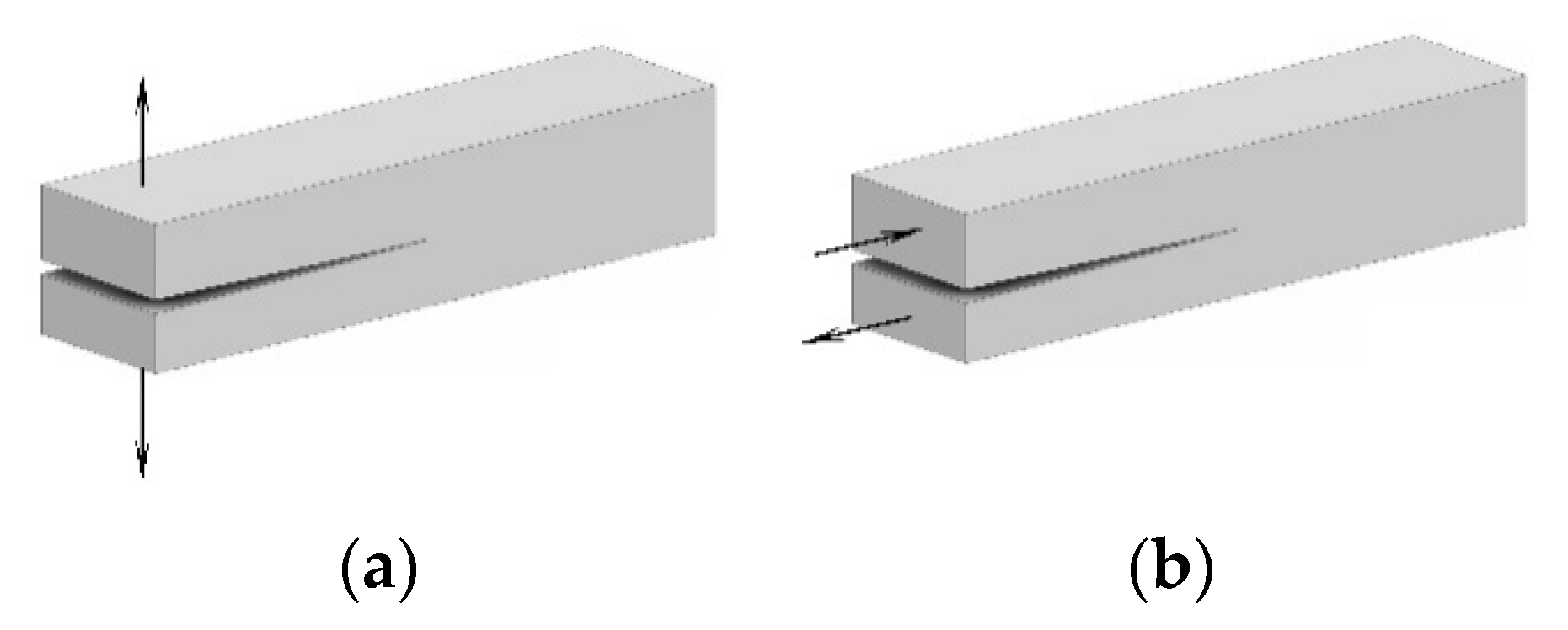

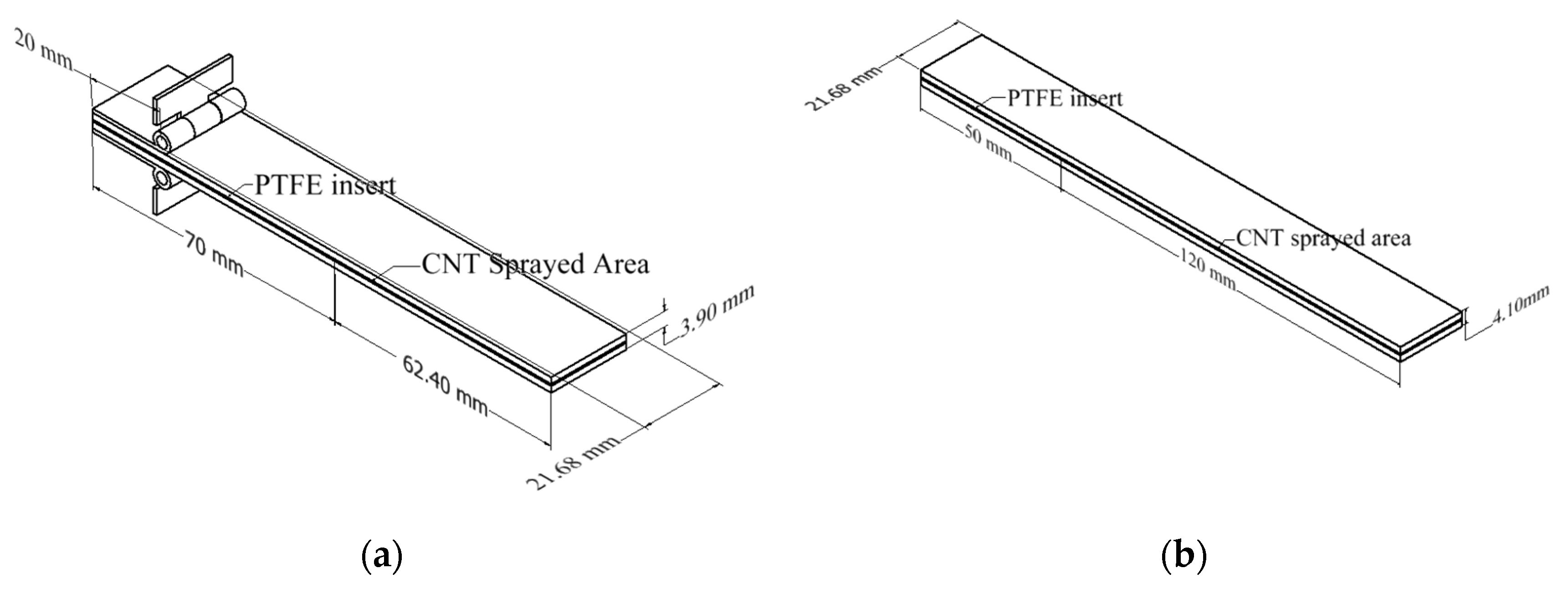

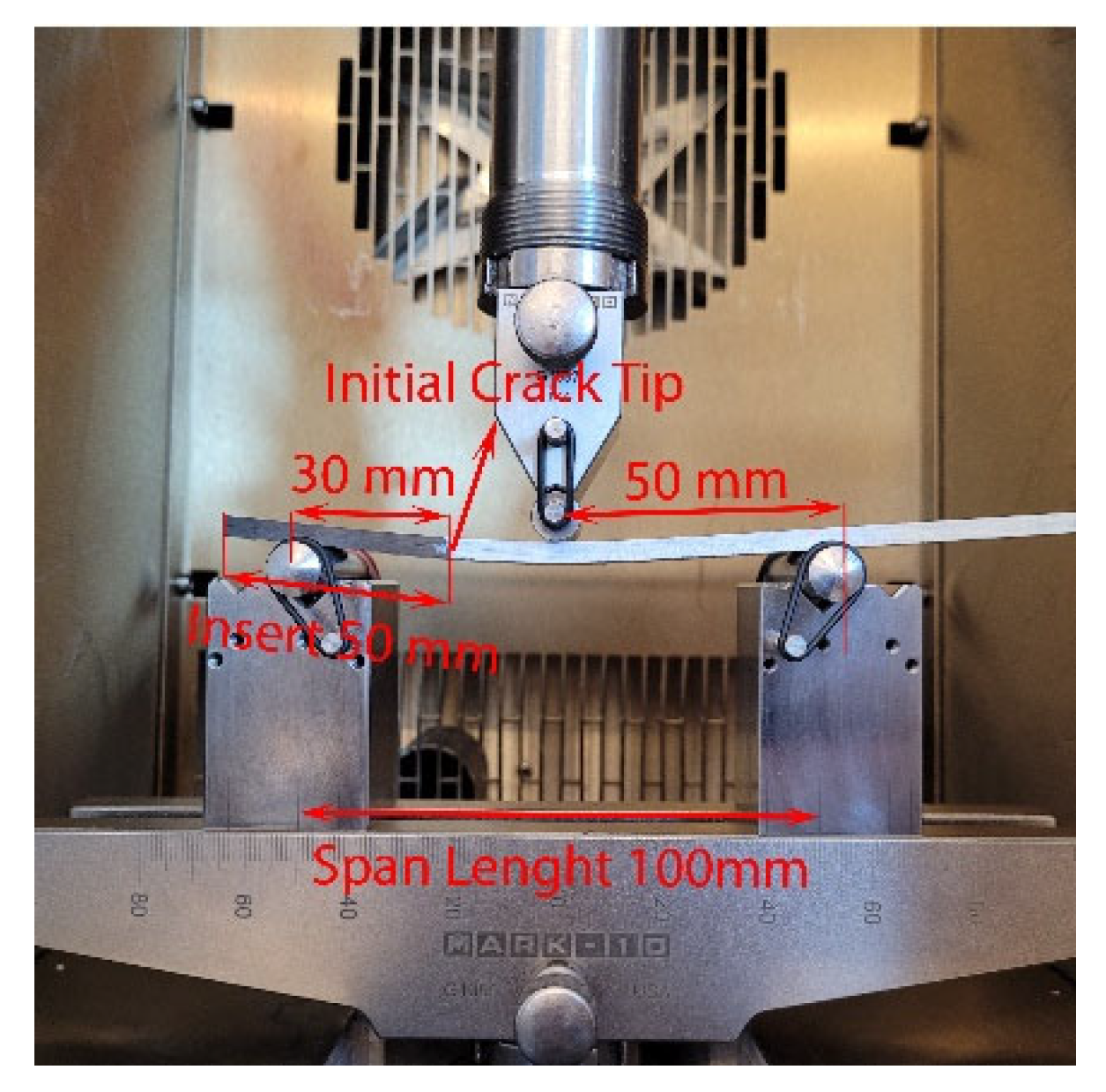



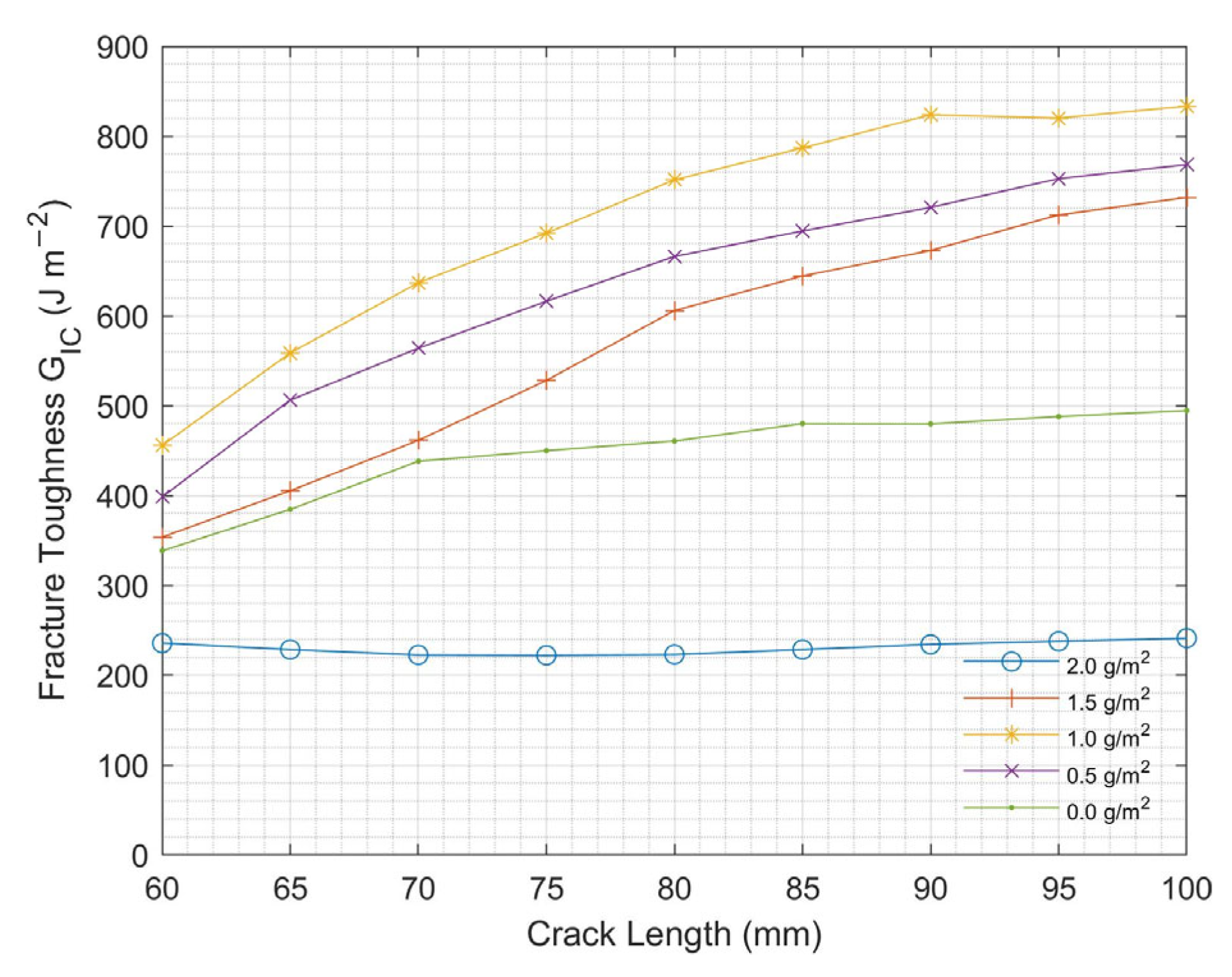
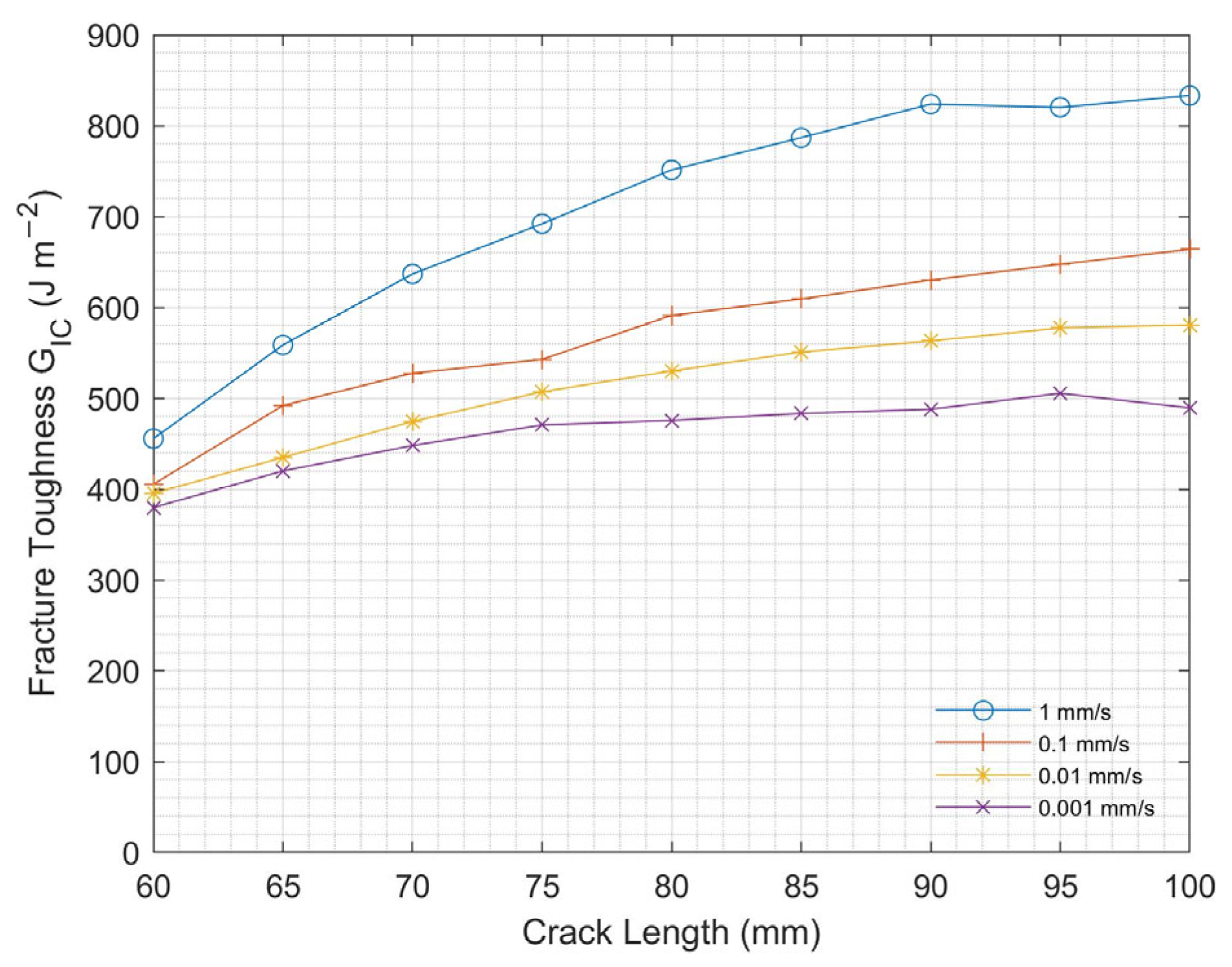

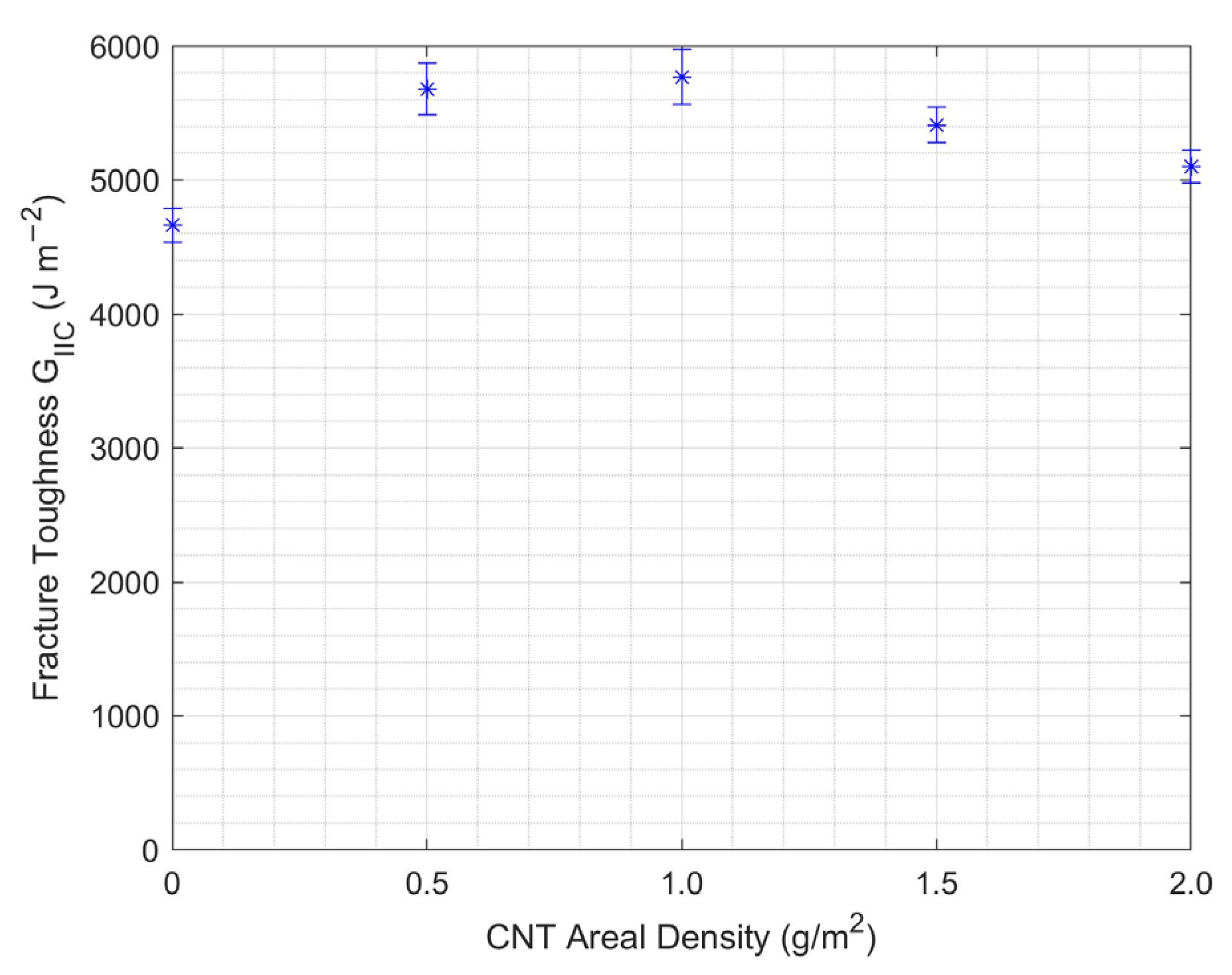



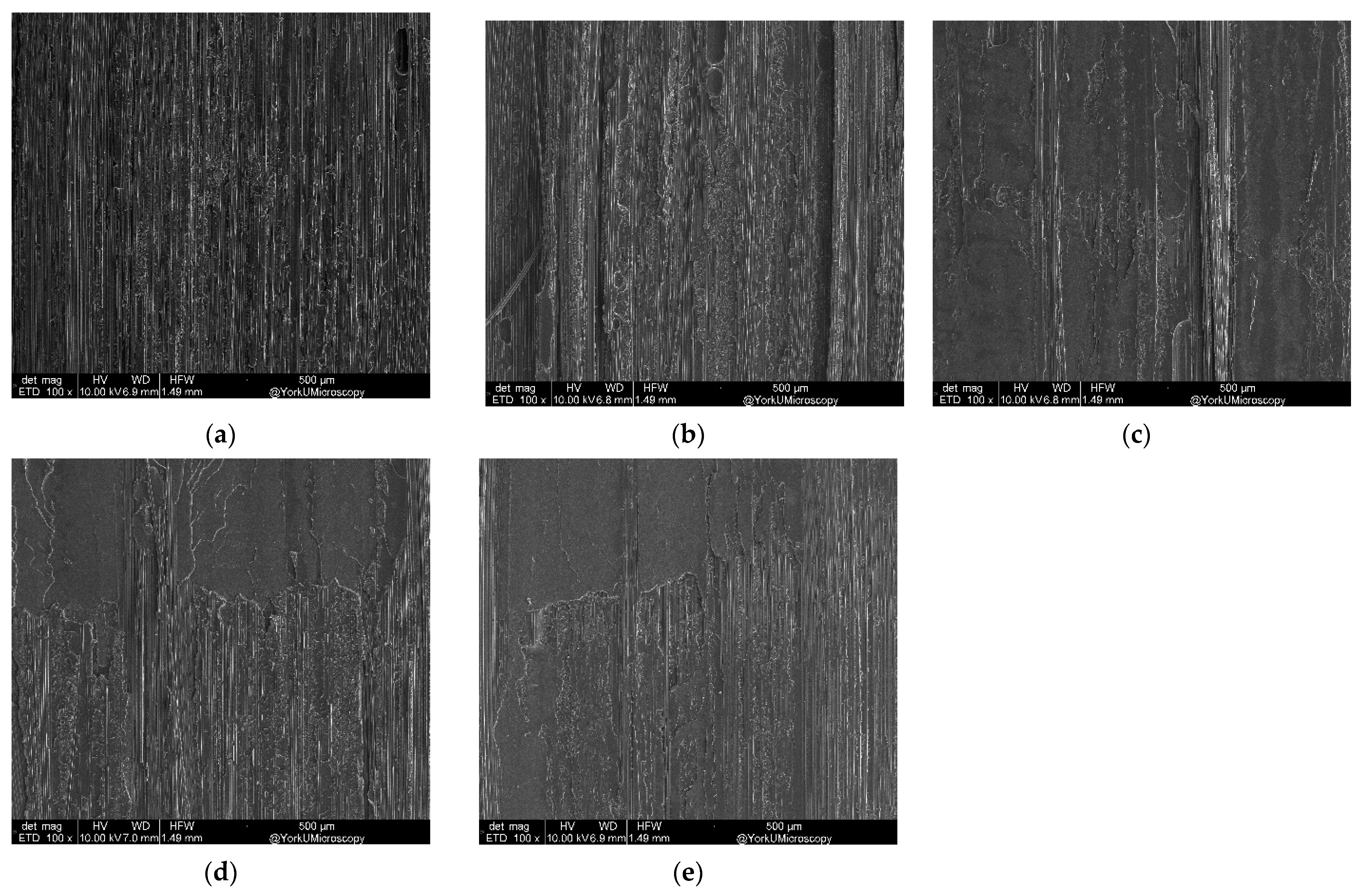
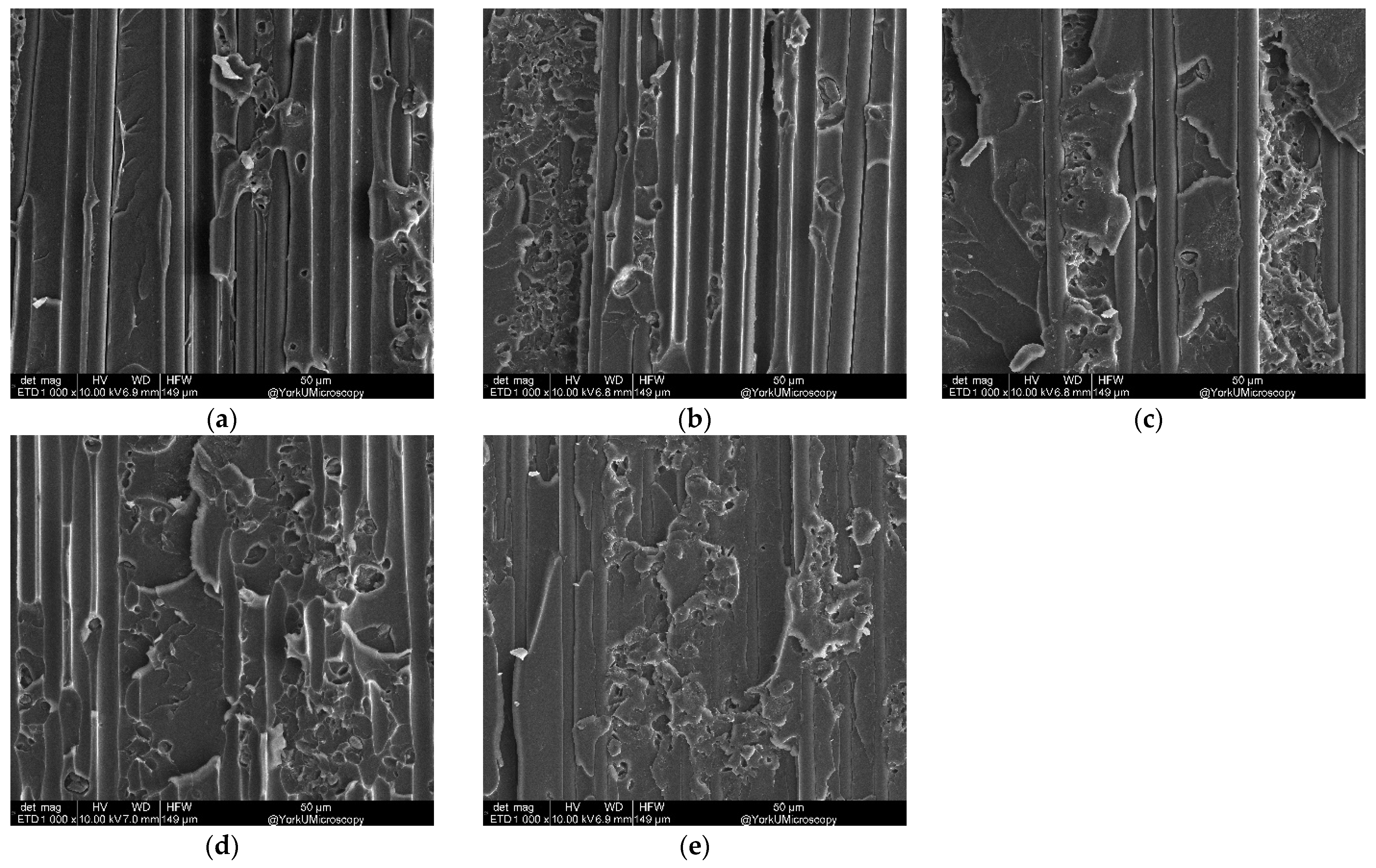

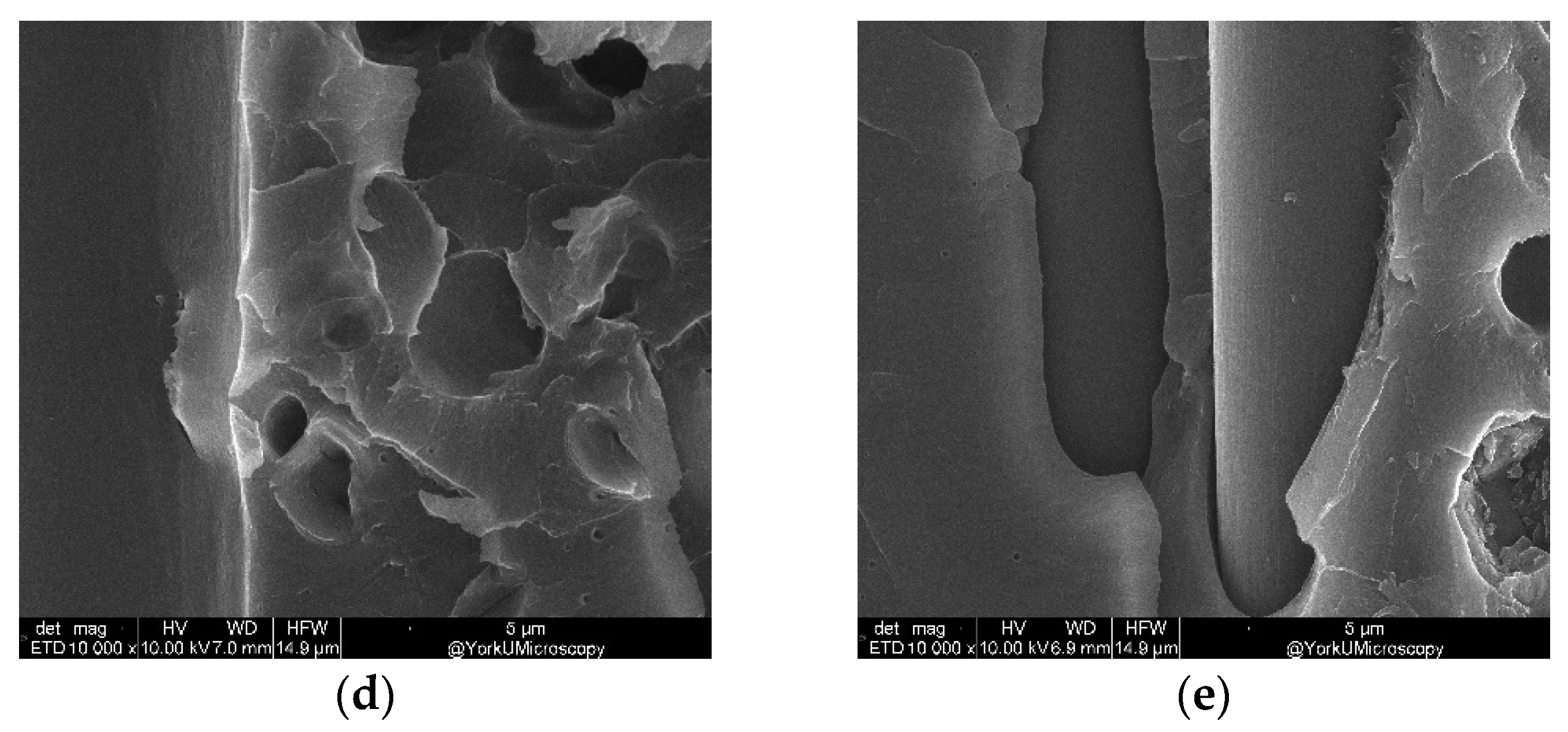
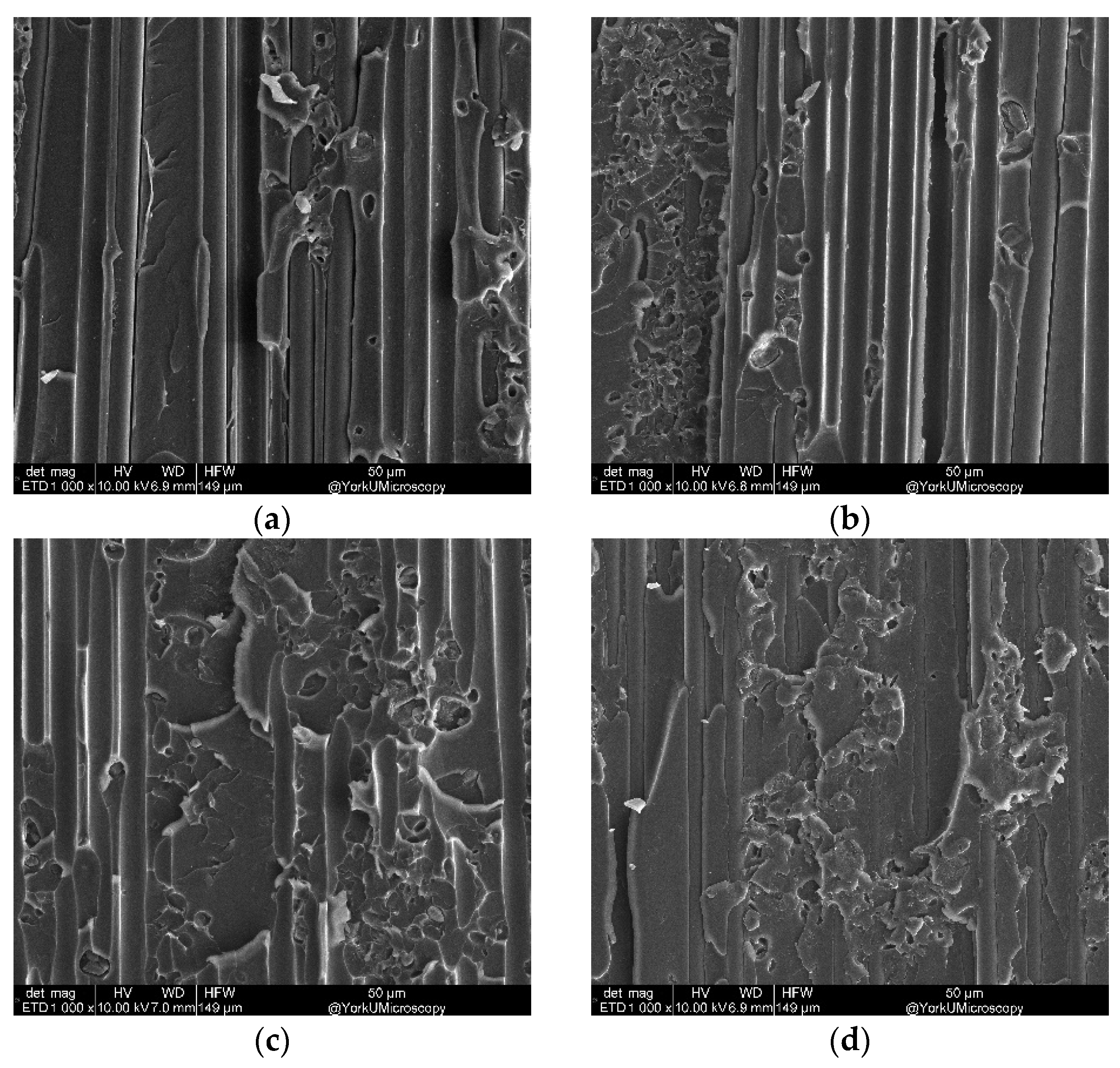
| Test Groups (Objective) | Constant Values | Variables |
|---|---|---|
| 1—CNT Density (g/m2) | 20 °C, 1 mm/s | 0, 0.5, 1, 1.5, 2 [g/m2] |
| 2—Loading Rate (mm/s) | 20 °C, 1 g/m2 | 0.001, 0.01, 0.1, 1 [mm/s] |
| 3—Temperature | 1 mm/s, 1 g/m2 | −60, −20, 20, 60 [°C] |
| Temperature (°C) | Change (%) | Speed (mm/s) | Change (%) | Areal Density (g/m2) | Change (%) |
|---|---|---|---|---|---|
| −60 | −26% | 0.001 | −39% | 0 | −40.7% |
| −20 | −10% | 0.01 | −30% | 0.5 | −7.8% |
| 20 | REF | 0.1 | −20% | 1 | REF |
| 60 | 7% | 1 | REF | 1.5 | −12.2% |
| 2 | −62.1% |
Disclaimer/Publisher’s Note: The statements, opinions and data contained in all publications are solely those of the individual author(s) and contributor(s) and not of MDPI and/or the editor(s). MDPI and/or the editor(s) disclaim responsibility for any injury to people or property resulting from any ideas, methods, instructions or products referred to in the content. |
© 2023 by the authors. Licensee MDPI, Basel, Switzerland. This article is an open access article distributed under the terms and conditions of the Creative Commons Attribution (CC BY) license (https://creativecommons.org/licenses/by/4.0/).
Share and Cite
Yenigun, B.; Chaudhry, M.S.; Gkouti, E.; Czekanski, A. Characterization of Mode I and Mode II Interlaminar Fracture Toughness in CNT-Enhanced CFRP under Various Temperature and Loading Rates. Nanomaterials 2023, 13, 1729. https://doi.org/10.3390/nano13111729
Yenigun B, Chaudhry MS, Gkouti E, Czekanski A. Characterization of Mode I and Mode II Interlaminar Fracture Toughness in CNT-Enhanced CFRP under Various Temperature and Loading Rates. Nanomaterials. 2023; 13(11):1729. https://doi.org/10.3390/nano13111729
Chicago/Turabian StyleYenigun, Burak, Muhammad Salman Chaudhry, Elli Gkouti, and Aleksander Czekanski. 2023. "Characterization of Mode I and Mode II Interlaminar Fracture Toughness in CNT-Enhanced CFRP under Various Temperature and Loading Rates" Nanomaterials 13, no. 11: 1729. https://doi.org/10.3390/nano13111729





